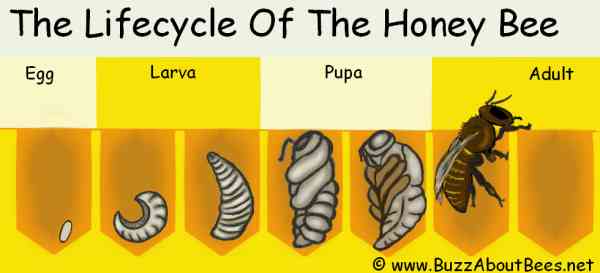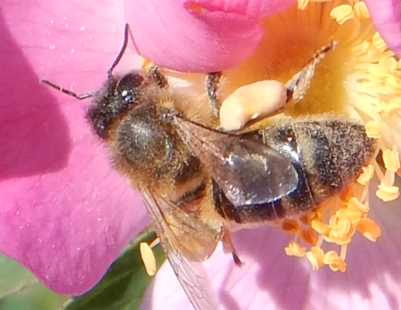Honey Bee Life Cycle
The 4 stages of the life cycle of Apis mellifera from egg to adult.
The life cycle of the honey bee begins firstly with the mating of the queen honey bee with drones (males). To do this, the queen will leave the hive or nest on a mating flight, where she will mate mid air up to 24 times.
You can watch this amazing spectacle on my page about honey bee mating behaviour.
The impregnated queen returns to join the rest of the colony in the nest or hive, where she will lay the eggs that will develop into adult bees.
The Honey Bee Life Cycle: The 4 Stages From Egg To Adult
The honey bee life cycle has 4 basic stages between egg and adult bee, whether it is a worker, drone or queen, although there will be slight variations in the time it takes for each to emerge from the egg cell.
As with all insects, bees go through a process called metamorphosis as the bee develops from a larva to and adult.
The development of a drone from egg to adult takes about 24 days, whereas queen and worker development is quicker.
| Average time taken for an egg to develop into an adult bee |
|
|---|---|
| Worker | 18 - 22 days |
| Queen | 16 days |
| Drone | 24 days |
The life cycle of all bee species passes includes 4 key stages, and honey bees are no different in this regard.
The 4 stages are:
- Egg
- Larva
- Pupa
- Adult
Let's go into this in a little more detail:
Egg
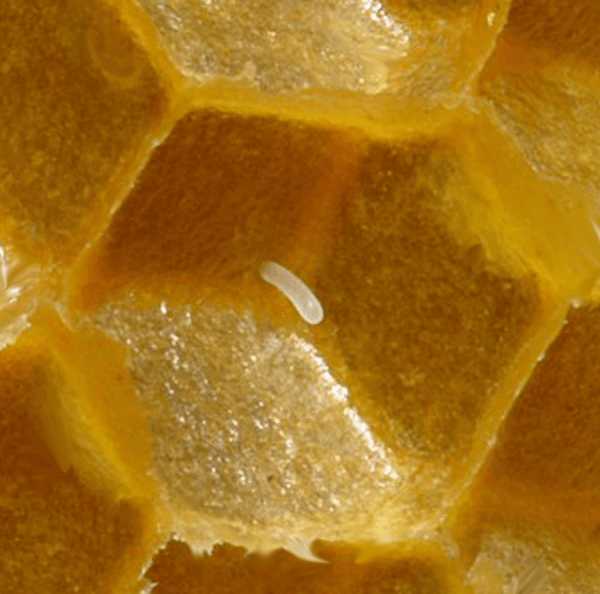 An egg is laid by the honey bee queen in an hexagonal egg cell. The egg is about the size of a grain of rice.
An egg is laid by the honey bee queen in an hexagonal egg cell. The egg is about the size of a grain of rice.
An egg is laid by the honey bee queen in a wax, hexagonal egg cell.
The egg is about the size of a grain of rice and initially stands upright in the cell, but falls onto its side by the third day. The honey bee queen may lay up to 2000 or 3000 eggs per day1,4.
Fertilized eggs will become females (workers or potential queens). Unfertilized eggs will become drones (male honey bees) and are laid in 'drone cells' which are larger cells than those of worker bees.
A potential future new queen honey bee is laid in a special cell, called a 'queen cell'.
Larva
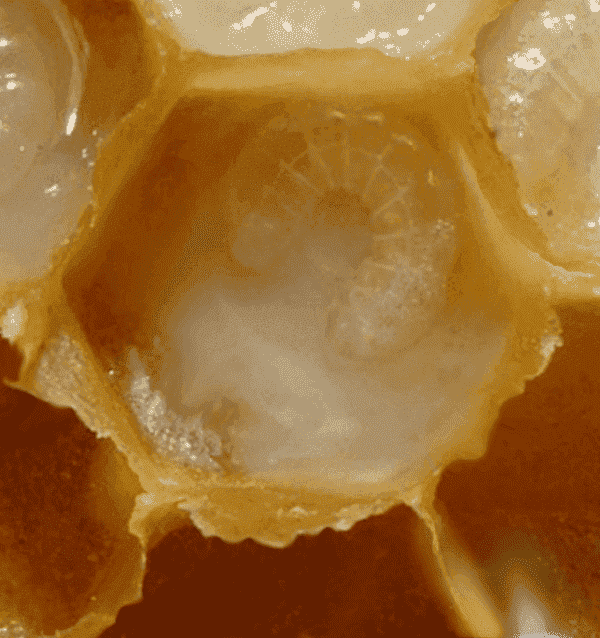 Honey bee larva inside a cell.
Honey bee larva inside a cell.
After 3 days, the egg develops into a larva, which looks like a small white grub. It has no legs and is blind.
The larvae are fed by young worker nurse bees that have not yet left the hive or nest. Larvae are fed either 'worker jelly' (female workers), 'drone jelly' (males) or 'royal jelly' (queen)2.
Initially, all the larvae of worker bees are fed jelly for 3 - 4 days, after which, workers are fed on a slightly different jelly containing less protein2.
Whereas adult worker bees will feed on pollen and honey, a larva destined to be a queen is fed only on royal jelly and will continue to be fed on royal jelly throughout her life3.
Royal jelly is a substance made in glands in the head, and the salivary glands in the mouth. Royal jelly is sometimes called 'bee milk' and is produced by young nurse bees (worker bees of between 5 and 14 days old).
Royal jelly contains water, protein, vitamins, fats (lipids), and sugar and some mineral salts4.
As the larva grows, it will moult (shed its outer skin) several times. After about 6 days (depending on whether the bee is a worker, drone or queen), the egg cell is covered with a layer of wax by the worker bees.
Pupa
Inside the sealed egg cell, the larva begins to spin a cocoon around itself and pupate.
During this phase, the larva develops into a recognisable bee, with wings, legs, head, thorax and abdomen.
Adult
Eventually, a young adult bee will emerge from the hexagonal-shaped egg cell, by chewing its way through the wax capping.
All in all, from the time the egg was laid, it takes new honey bee queens about 16 days to emerge from the egg cell, whereas worker bees require between 18 and 22 days to fully develop, and drones need 24 days.
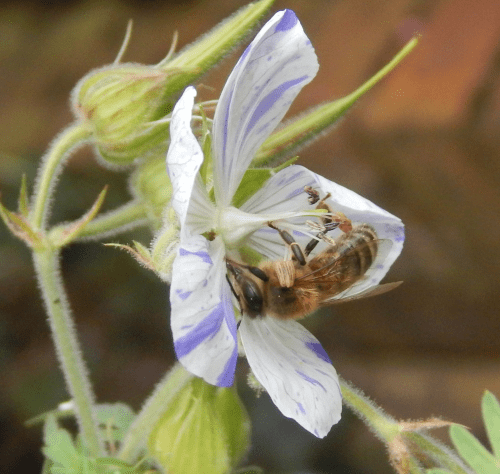 Honey bee - Apis mellifera on geranium flower.
Honey bee - Apis mellifera on geranium flower.The honey bee life cycle captured on video...
Here is a wonderful video from National Geographic showing the development of the eggs through to the stages of larvae, pupae and finally the emerging adult honey bees:
What happens to the honey bee colony?
Unlike
bumble bee colonies, honey bee (Apis mellifera) colonies can survive the winter, provided
they have enough food resources, are able to keep sufficiently warm,
and are free of diseases and predators.
However, in the winter, colonies are smaller than in the summer: there are no drones (drones are evicted from the colony), and perhaps part of the original colony left the hive (in a swarm) to form a new colony and nest elsewhere.
Some of the workers will also die naturally during the winter months, however, there may be up to 20,000 workers left, and a queen.
The queen and the rest of the colony will form a winter cluster to keep warm during the cold months.
There will be no brood to tend to, and no eggs are laid during this time.
However, as the days begin to warm up, and the flowers begin to bloom, honey bees will begin to go out foraging again, and the queen honey bee will begin to lay eggs.
For How Long Do Honey Bees Live?
What is the lifespan of the different members of the honey bee colony (drones, worker and queen honey bees)?
The life spans of honey bees differ depending on their function in the colony, and when they emerged in the season.
I have written a page comparing the lifespans of the different types of bees, called
How Long Do Bees Live?
Drones
The average lifespan of a drone is 55 days. Drones that mate with new honey bee
queens, will die immediately after mating. However, there are reports of drones living to about 90 days - or about 12 - 13 weeks5.
By the end of the summer, they will no longer be needed by the colony. Honey bees are quite tolerant of fairly cool temperatures, but need reasonable weather conditions (e.g. no snow or heavy rain) to forage, and of course, during the winter time, there is far less nectar and pollen available.
Drones do not collect pollen or nectar, and before winter sets in, those still alive will be elbowed out of the nest or hive by the workers, so that winter food resources are not drained!
Workers
Workers raised in the spring and
summer have shorter, busier lives than those raised later in the season, and may live 6 or 7 weeks. This is
the most productive time for the colony, with larvae to be fed, nectar
and pollen to be gathered, and honeycomb to be built.
Those
raised in the autumn will have far less to do, with no brood to care
for. Their main concern will be to survive the cold until the following
spring. However, they may live 4 to 6 months.
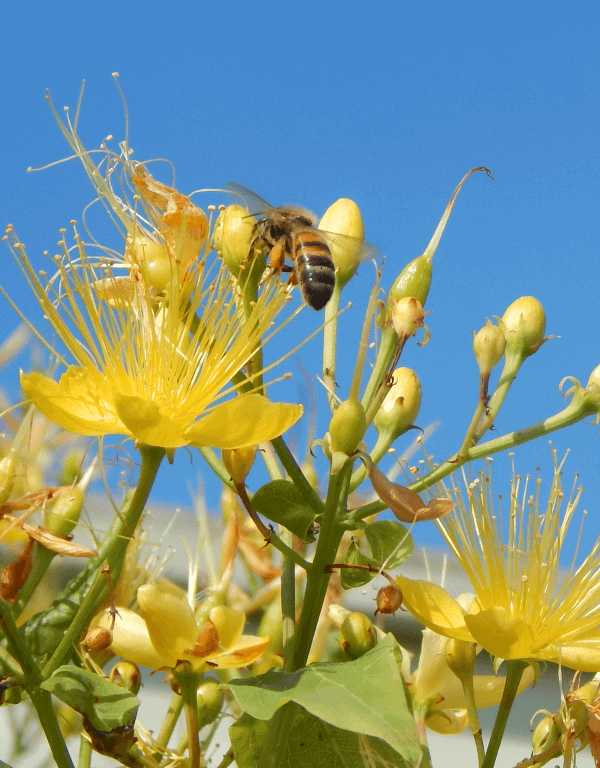 Honey bee worker - Apis mellifera on Hypericum
Honey bee worker - Apis mellifera on HypericumWhereas the queen honey bee life cycle revolves primarily around mating and laying eggs, the life of worker honey bees also progresses through various stages and functions within the colony.
Sometimes, workers will also lay eggs, but such activity is usually suppressed by the queen, or eggs are destroyed by other members of the colony.
Read more about the different jobs of worker bees.
Queen honey bees
A productive queen, favoured by the
colony and free from disease should certainly live for about 2 yrs, but
could live for up to 3 or 4 years or even longer, partly depending on whether the
beekeeper decides to get rid of the queen, or whether the colony decides to replace her with a new queen.
The act of deposing the queen by the colony is called
‘supersedure’. Learn more about the role of the
Honey Bee Queen.
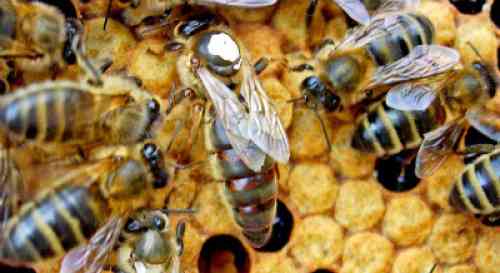 The honey bee queen is larger than the workers and drones, but may be difficult to spot within the colony. Beekeepers often use a special paint to mark her thorax, making identification easier.
The honey bee queen is larger than the workers and drones, but may be difficult to spot within the colony. Beekeepers often use a special paint to mark her thorax, making identification easier.
Queens are difficult for beekeepers to identify among the thousands of workers in the hive.
So that they can find the queen more easily, beekeepers sometimes mark her with a spot on the thorax using a special bee paint as can be seen on the photograph above.
Size of honey bee drone, queen, and worker
| Average size (length) of a honey bee by colony member | |
|---|---|
| Worker | 0.4 inches / 1 cm |
| Queen | 0.8 inches / 2 cm |
| Drone | 0.6 inches / 1.5 cm |
The image below give you an idea about the relative size of the honey bee drone, queen and worker.
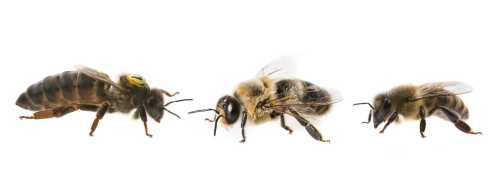
Are all bee life cycles the same?
All
bee life cycles
go through the stages of egg, larva, pupa then adult, although there are great variations between the
that of solitary, honey and bumble bee life cycles.
I hope you enjoyed reading about the honey bee life cycle, but you can learn a lot more about some of the specific stages, such as swarming, by exploring the site further.
References:
- Chittka A, Chittka L. Epigenetics of royalty. PLoS Biol. 2010;8(11):e1000532. Published 2010 Nov 2. doi:10.1371/journal.pbio.1000532
- Matteo A. Lucchetti, Verena Kilchenmann, Gaetan Glauser, Christophe Praz and Christina Kast. Nursing protects honeybee larvae from secondary metabolites of pollen. Proceedings of the Royal Society B: Biological SciencesVolume 285, Issue 1875
- Yang W, Tian Y, Han M, Miao X. Longevity extension of worker honey bees (Apis mellifera) by royal jelly: optimal dose and active ingredient. PeerJ. 2017;5:e3118. Published 2017 Mar 28. doi:10.7717/peerj.3118
- Fratini et al: Royal Jelly: An ancient remedy with remarkable antibacterial properties; Microbiological Research Volume 192, November 2016, Pages 130-141.
- Fukuda H, Ohtani T. Survival and lifespan of drone honeybees. Res. Popul. Ecol. 1977;19:51–68.
If you found this page helpful or interesting, I'd really be grateful if you would share it with others - if not this page, perhaps another, such as Gardening For Bees.
Thank you so much :) .
